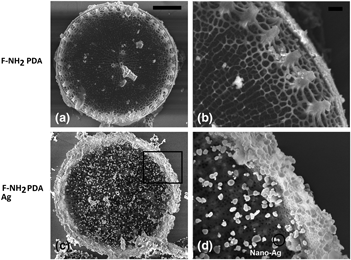Crossref Citations
This article has been cited by the following publications. This list is generated based on data provided by
Crossref.
Vona, Danilo
Mezzina, Nicoletta
Cicco, Stefania Roberta
Leone, Gabriella
Ragni, Roberta
Lo Presti, Marco
Farinola, Gianluca M.
Parak, Wolfgang J.
and
Osiński, Marek
2019.
Diatomaceous earth/polydopamine hybrid microstructures as enzymes support for biological applications.
p.
13.
Presti, Marco Lo
Vona, Danilo
Leone, Gabriella
Rizzo, Giorgio
Ragni, Roberta
Cicco, Stefania R.
Milano, Francesco
Palumbo, Fabio
Trotta, Massimo
and
Farinola, Gianluca M.
2019.
Nanostructured interfaces between photosynthetic bacterial Reaction Center and Silicon electrodes.
MRS Advances,
Vol. 4,
Issue. 31-32,
p.
1741.
Cicco, Stefania R.
Vona, Danilo
Leone, Gabriella
De Giglio, Elvira
Bonifacio, Maria A.
Cometa, Stefania
Fiore, Saverio
Palumbo, Fabio
Ragni, Roberta
and
Farinola, Gianluca M.
2019.
In vivo functionalization of diatom biosilica with sodium alendronate as osteoactive material.
Materials Science and Engineering: C,
Vol. 104,
Issue. ,
p.
109897.
Lomora, Mihai
Shumate, David
Rahman, Asrizal Abdul
and
Pandit, Abhay
2019.
Therapeutic Applications of Phytoplankton, with an Emphasis on Diatoms and Coccolithophores.
Advanced Therapeutics,
Vol. 2,
Issue. 2,
Leone, Gabriella
Vona, Danilo
De Giglio, Elvira
Bonifacio, Maria Addolorata
Cometa, Stefania
Fiore, Saverio
Palumbo, Fabio
Ragni, Roberta
Farinola, Gianluca M.
and
Cicco, Stefania R.
2019.
Data from in vivo functionalization of diatom mesoporous biosilica with bisphosphonates.
Data in Brief,
Vol. 24,
Issue. ,
p.
103831.
Della Rosa, Giulia
Vona, Danilo
Aloisi, Alessandra
Ragni, Roberta
Di Corato, Riccardo
Lo Presti, Marco
Cicco, Stefania R.
Altamura, Emiliano
Taurino, Antonietta
Catalano, Massimo
Farinola, Gianluca M.
and
Rinaldi, Rosaria
2019.
Luminescent Silica-Based Nanostructures from in Vivo Iridium-Doped Diatoms Microalgae.
ACS Sustainable Chemistry & Engineering,
Vol. 7,
Issue. 2,
p.
2207.
Leone, G.
Ragni, R.
Vona, D.
Cicco, S. R.
Babudri, F.
and
Farinola, G. M.
2020.
A phosphorescent iridium complex as a probe for diatom cells’ viability.
MRS Advances,
Vol. 5,
Issue. 18-19,
p.
935.
Singh, Ramesh
Khan, Mohd Jahir
Rane, Jagdish
Gajbhiye, Ashmita
Vinayak, Vandana
and
Joshi, Khashti Ballabh
2020.
Biofabrication of Diatom Surface by Tyrosine‐Metal Complexes:Smart Microcontainers to Inhibit Bacterial Growth.
ChemistrySelect,
Vol. 5,
Issue. 10,
p.
3091.
Latypova, Adele R.
Lebedev, Maxim D.
Rumyantsev, Evgeniy V.
Filippov, Dmitry V.
Lefedova, Olga V.
Bykov, Alexey V.
and
Doluda, Valentin Yu.
2020.
Amino-Modified Silica as Effective Support of the Palladium Catalyst for 4-Nitroaniline Hydrogenation.
Catalysts,
Vol. 10,
Issue. 4,
p.
375.
Roychoudhury, Piya
Golubeva, Aleksandra
Dąbek, Przemysław
Gloc, Michał
Dobrucka, Renata
Kurzydłowski, Krzysztof
and
Witkowski, Andrzej
2021.
Diatom Mediated Production of Fluorescent Flower Shaped Silver-Silica Nanohybrid.
Materials,
Vol. 14,
Issue. 23,
p.
7284.
Roychoudhury, Piya
Dąbek, Przemysław
Gloc, Michał
Golubeva, Aleksandra
Dobrucka, Renata
Kurzydłowski, Krzysztof
and
Witkowski, Andrzej
2021.
Reducing Efficiency of Fucoxanthin in Diatom Mediated Biofabrication of Gold Nanoparticles.
Materials,
Vol. 14,
Issue. 15,
p.
4094.
Wang, Taoran
Wusigale
Kuttappan, Deepa
Amalaradjou, Mary Anne
Luo, Yaguang
and
Luo, Yangchao
2021.
Polydopamine-coated chitosan hydrogel beads for synthesis and immobilization of silver nanoparticles to simultaneously enhance antimicrobial activity and adsorption kinetics.
Advanced Composites and Hybrid Materials,
Vol. 4,
Issue. 3,
p.
696.
Agilan, Perumal
Saranya, Kannan
and
Rajendran, Nallaiyan
2021.
Bio-inspired polydopamine incorporated titania nanotube arrays for biomedical applications.
Colloids and Surfaces A: Physicochemical and Engineering Aspects,
Vol. 629,
Issue. ,
p.
127489.
Shafiei, Nasrin
Nasrollahzadeh, Mahmoud
and
Iravani, Siavash
2021.
Green Synthesis of Silica and Silicon Nanoparticles and Their Biomedical and Catalytic Applications.
Comments on Inorganic Chemistry,
Vol. 41,
Issue. 6,
p.
317.
Leone, Gabriella
De la Cruz Valbuena, Gabriel
Cicco, Stefania Roberta
Vona, Danilo
Altamura, Emiliano
Ragni, Roberta
Molotokaite, Egle
Cecchin, Michela
Cazzaniga, Stefano
Ballottari, Matteo
D’Andrea, Cosimo
Lanzani, Guglielmo
and
Farinola, Gianluca Maria
2021.
Incorporating a molecular antenna in diatom microalgae cells enhances photosynthesis.
Scientific Reports,
Vol. 11,
Issue. 1,
Lo Presti, Marco
Vona, Danilo
Ragni, Roberta
Cicco, Stefania R.
and
Farinola, Gianluca Maria
2021.
Perspectives on applications of nanomaterials from shelled plankton.
MRS Communications,
Vol. 11,
Issue. 3,
p.
213.
Vicente-Garcia, Cesar
Losacco, Valentina
Vona, Danilo
Cicco, Stefania R.
Altamura, Emiliano
Farinola, Gianluca Maria
and
Ragni, Roberta
2021.
Straightforward and effective removal of phenolic compounds from water by Polydopamine coated Diatomaceous Earth.
p.
27.
Mahendran, Logesh
Ravichandran, Abimanyu
and
Ballamurugan, A. M.
2022.
Organic and Inorganic Template-Assisted Synthesis of Silica Nanotubes and Evaluation of Their Properties.
Applied Biochemistry and Biotechnology,
Vol. 194,
Issue. 1,
p.
167.
Hussein, Hanaa Ali
Nazir, Muhammad Shahid
Azra, Nizakat
Qamar, Zeenat
Seeni, Azman
Tengku Din, Tengku Ahmad Damitri Al-Astani
and
Abdullah, Mohd Azmuddin
2022.
Novel Drug and Gene Delivery System and Imaging Agent Based on Marine Diatom Biosilica Nanoparticles.
Marine Drugs,
Vol. 20,
Issue. 8,
p.
480.
Aresta, Antonella
Cicco, Stefania R.
Vona, Danilo
Farinola, Gianluca Maria
and
Zambonin, Carlo
2022.
Mussel Inspired Polydopamine as Silica Fibers Coating for Solid-Phase Microextraction.
Separations,
Vol. 9,
Issue. 8,
p.
194.






